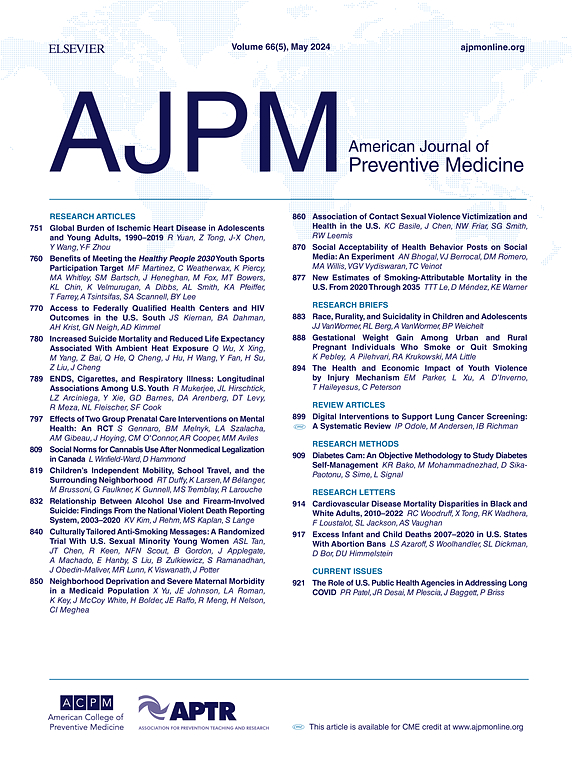俄勒冈州医疗补助背痛政策实施后阿片类药物的长期使用情况。
IF 4.3
2区 医学
Q1 MEDICINE, GENERAL & INTERNAL
引用次数: 0
摘要
导言:2016 年,俄勒冈州制定了一项创新政策,以改善对背痛医疗补助患者的护理。本研究的目的是确定该政策实施后,使用慢性阿片类药物治疗的医疗补助患者减少剂量和停止治疗的相关因素:本研究使用医疗补助行政报销数据,对 2016 年 7 月至 12 月期间接受慢性稳定阿片类药物治疗的患者进行了回顾性队列研究。评估结果为:1)阿片类药物剂量减少 30%;2)2017 年 1 月至 12 月期间绝对停药。多变量逻辑回归评估了剂量减少结果与临床和人口统计学因素之间的关联:在4643名接受阿片类药物慢性治疗的医疗补助患者中,3853人(83%)减少了剂量,651人(14%)停用了阿片类药物;背痛患者更有可能减少剂量(调整后的几率比 [aOR] 1.19;95% 1.01 至 1.41)。与停药相关的因素包括精神健康诊断(aOR 1.30;95% CI 1.08 至 1.56)、药物使用障碍(aOR 1.90;95% CI 1.41 至 2.56)、阿片类药物使用障碍(aOR 1.55;95% CI 1.21 至 1.99)以及接受丁丙诺啡治疗(aOR 2.82;95% CI 1.30 至 6.15)。黑人患者(aOR为0.50;95% CI为0.29至0.85)、年龄较大的患者以及阿片类药物基线剂量较高的患者停药的可能性较低:结论:俄勒冈州背痛政策实施后,大多数医疗补助受益人都减少了阿片类药物剂量。阿片类药物的停用与一些因素有关,建议医疗服务提供者对用药过量风险较高的患者采取这一策略。本文章由计算机程序翻译,如有差异,请以英文原文为准。
Chronic Opioid Use After Implementation of Oregon's Medicaid Back Pain Policy
Introduction
In 2016, Oregon developed an innovative policy to improve care for Medicaid patients with back pain. The objective of this study was to identify the factors associated with dose reduction and discontinuation among Medicaid patients using chronic opioid therapy after implementation of this policy.
Methods
Using Medicaid administrative claims data, this was a retrospective cohort of patients on chronic stable opioid therapy between July and December 2016. Outcomes assessed were (1) 30% reduction in opioid dose and (2) an absolute discontinuation between January and December 2017. Multivariable logistic regressions evaluated the association between dose reduction outcomes and clinical and demographic factors.
Results
Of 4,643 Medicaid patients on chronic opioid therapy, 3,853 (83%) had a dose reduction, and 651 (14%) discontinued opioids; patients with back pain were more likely to have a dose reduction (AOR=1.19; 95% CI=1.01, 1.41). Factors associated with discontinuation included having a mental health diagnosis (AOR=1.30; 95% CI=1.08, 1.56), substance use disorder (AOR=1.90; 95% CI=1.41, 2.56), opioid use disorder (AOR=1.55; 95% CI=1.21, 1.99), and receipt of buprenorphine (AOR=2.82; 95% CI=1.30, 6.15). Discontinuation was less likely in Black patients (AOR=0.50; 95% CI=0.29, 0.85), in older age groups, and in those with a higher opioid dose at baseline.
Conclusions
Most Medicaid beneficiaries had a dose reduction after implementation of Oregon's back pain policy. Opioid discontinuation was associated with factors that suggest that providers pursue this strategy for patients at higher overdose risk.
求助全文
通过发布文献求助,成功后即可免费获取论文全文。
去求助
来源期刊

American Journal of Preventive Medicine
医学-公共卫生、环境卫生与职业卫生
CiteScore
8.60
自引率
1.80%
发文量
395
审稿时长
32 days
期刊介绍:
The American Journal of Preventive Medicine is the official journal of the American College of Preventive Medicine and the Association for Prevention Teaching and Research. It publishes articles in the areas of prevention research, teaching, practice and policy. Original research is published on interventions aimed at the prevention of chronic and acute disease and the promotion of individual and community health.
Of particular emphasis are papers that address the primary and secondary prevention of important clinical, behavioral and public health issues such as injury and violence, infectious disease, women''s health, smoking, sedentary behaviors and physical activity, nutrition, diabetes, obesity, and substance use disorders. Papers also address educational initiatives aimed at improving the ability of health professionals to provide effective clinical prevention and public health services. Papers on health services research pertinent to prevention and public health are also published. The journal also publishes official policy statements from the two co-sponsoring organizations, review articles, media reviews, and editorials. Finally, the journal periodically publishes supplements and special theme issues devoted to areas of current interest to the prevention community.
 求助内容:
求助内容: 应助结果提醒方式:
应助结果提醒方式:


